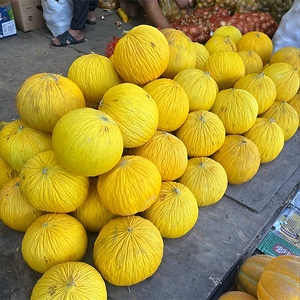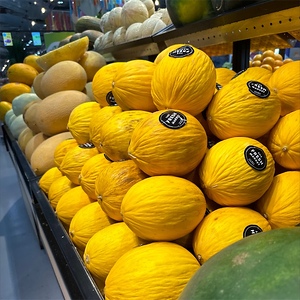


Casaba Melons
Estimated Inventory, 22 lbs : 0
Description/Taste
Casaba melons are small to medium in size, averaging 3 to 8 pounds, and are found in varying shapes, sometimes appearing round, oval, to acorn-shaped. The melons generally taper to a slight point on the stem end and have a thick, tough, and smooth rind, textured with longitudinal furrows, wrinkles, and folds. Each melon has a unique appearance, and the irregular creases will be different depending on growing conditions and specific variety. The rind also transitions from green to golden yellow with green undertones when ripe. Underneath the surface, the flesh is dense, slippery, aqueous, tender, and succulent, showcasing pale green to white shades. There is also a central cavity filled with oval, tan seeds suspended between white fibers and liquid. Casaba melons emit a mild aroma, and the blossom end will yield slightly under pressure as a sign of maturity. The flesh is subtly sweet and musky, combined with cucumber and Asian pear nuances, followed by a faint spice-filled warmth.
Seasons/Availability
Casaba melons are available in the late summer through the early winter. The melons are also grown in both hemispheres, providing extended availability.
Current Facts
Casaba melons, botanically classified as Cucumis melo var. inodorus, are late-maturing muskmelons belonging to the Cucurbitaceae family. The unusually shaped and brightly colored melons grow on trailing vines and are a type of winter melon, requiring at least one hundred frost-free days to reach maturity. Casaba melons are also highly favored for their hardiness, long-shelf-life, and juicy consistency. The melons have a long growing season and are harvested by cutting the stems when the fruits are mature. Unlike other melon varieties, Casaba melons do not “slip” from the vine at maturity and must be monitored to harvest at peak ripeness. In commercial markets, Casaba melons are sold as a specialty melon, primarily consumed as a dessert cultivar. The melons are utilized fresh in savory and sweet preparations and are showcased for their aqueous nature. The name Casaba is a general descriptor used to encompass several varieties, including Golden Beauty, Winter Pineapple, Santa Claus, and Crenshaw.
Nutritional Value
Casaba melons are a good source of vitamin C to strengthen the immune system, vitamin B6 to maintain amino acid levels in the bloodstream, and folate to develop red blood cells. The melons also provide potassium to balance fluid levels within the body, fiber to stimulate the digestive tract, magnesium to regulate nerve and muscle functions, and contain lower amounts of calcium.
Applications
Casaba melons have a subtly sweet and mild flavor well suited for both sweet and savory preparations. The melons should be washed before cutting, as the furrows can hold excess dirt, and the thick rind, seeds, and fibers are discarded after slicing. Once prepared, Casaba melon flesh can be tossed into green or fruit salads, chopped into salsa, wrapped in cured meats as an appetizer, or consumed straight, out of hand, sometimes sprinkled with ginger, chile powder, salt, black pepper, or lemon or lime juice. Casaba melons can also be blended into smoothies, shakes, fruit juices, and cocktails, pureed into chilled soups such as gazpacho or used to flavor popsicles and sorbet. In addition to fresh preparations, Casaba melons are served with fried foods as a refreshing reprieve, lightly grilled for a savory-sweet taste, caramelized and served with roasted meats, or incorporated into curries. Casaba melons pair well with herbs such as basil, mint, and cilantro, other fruits including coconut, berries, citrus, and kiwis, salty cheeses, cucumber, and red onion. Whole, unwashed Casaba melons should be kept at room temperature until the blossom end gives slightly under pressure. Once ripe, the melons can be stored in the refrigerator for up to five days. Sliced Casaba melons should be placed in a sealed container, where they will keep up to three days in the fridge.
Ethnic/Cultural Info
In the United States, Casaba melons are grown throughout the Imperial Valley, a region in Southern California that travels along the Mexico and United States border. The valley is mostly below sea level and is part of the Colorado Desert, known for its mild winter climate and hot, extreme temperatures in the summer with ample sunshine. The Imperial Valley was overlooked as a viable, inhabitable region until the construction of the Imperial Canal in 1901. This canal diverted water from the Colorado River into the valley, providing a source of irrigation for extensive agriculture. Other dams and canals were constructed in the mid-1930s and 1940s, eventually contributing to the development of over 3,000 miles of irrigation canals. Melons were first grown in the Imperial Valley in the early 1900s, and by the 1950s, when the irrigation channels were built, over 40% of the melon production in California was found in the valley. California has remained the leading source of melons within the United States in the present day, and the valley is well-suited for spring melon production, creating varieties with high sugar content.
Geography/History
Casaba melons are believed by experts to be native to Persia and have been cultivated for thousands of years. In the Early Ages, the melons were spread throughout Asia Minor and were also introduced into the rest of Asia and Europe, where they were consumed as a dessert variety. Casaba melons were brought to the United States in the late 19th century and were imported from Kasaba, Turkey, a city that inspired the melon’s commercial name. The melons were also introduced to California by Armenian immigrants sometime during the 20th century, expanding cultivation across the country. Today Casaba melons are primarily cultivated in the southwestern United States, specifically in Arizona and California’s San Joaquin and Imperial Valleys. They are also grown in countries throughout South America for increased availability and are exported to Europe, Asia, and North America. When in season, Casaba melons are found through farmer’s markets, specialty grocers, and distributors worldwide.
Recipe Ideas
Recipes that include Casaba Melons. One
| The Food in my Beard |
|
Casaba Melon and Mint Salsa |
| DJ Foodie |
|
Chilled Melon & Cucumber Soup |
| The Cilantropist |
|
Melon Cucumber Salad with Lime and Mint |

















